Tagetes minuta, also known as southern cone marigold, stinking roger or black mint, is a tall upright marigold plant from the genus Tagetes, with small flowers, native to the southern half of South America. Since Spanish colonization, it has been introduced around the world, and has become naturalized in Europe, Asia, Australasia, North America, and Africa.
 It is used as a culinary herb in Peru, Ecuador, and parts of Chile and Bolivia. It is called by the Quechua terms wakatay in Peru or wakataya in Bolivia. It is commonly sold in Latin grocery stores in a bottled, paste format as black mint paste.
It is used as a culinary herb in Peru, Ecuador, and parts of Chile and Bolivia. It is called by the Quechua terms wakatay in Peru or wakataya in Bolivia. It is commonly sold in Latin grocery stores in a bottled, paste format as black mint paste.
The oil is also used to treat open wounds, parasites and other things.Tagetes contains Anthelminthic, carminative, diaphragmatic, antispasmodic, bactericidal, emmenagogue, fungicidal, and stomachic properties. These active elements make Tagetes as great medical herb. Several pharmaceutical products are made by tagetes oil. Also in some places, the oil is used in making herbaceous and floral perfumes.If you are suffering from any of the following diseases: Athlete’s foot, bunions, calluses, chest infections, corns, coughs catarrh, , fungal infections, and parasitic infections, tagetes oil can really cure you. You can also use the oil with blending with jasmine, lemon, bergamot, clary sage etc citrus oils.
Tagetes erecta, the Mexican marigold, also called Aztec marigold, is a species of the genus Tagetes native to Mexico and Central America. Despite its being native to the Americas, it is often called African marigold. In Mexico, this plant is found in the wild in the states of San Luis Potosí, Chiapas, State of México, Puebla, Sinaloa, Tlaxcala, and Veracruz. This plant reaches heights of between 50–100 cm (20–39 in). The Aztecs gathered the wild plant as well as cultivating it for medicinal, ceremonial and decorative purposes. It is widely cultivated commercially with many cultivars in use as ornamental plants, and for the cut-flower trade.
Landscape Uses:Border, Container, Foundation, Massing, Seashore, Specimen. Requires a well-drained moderately fertile soil in a sunny position[200]. Grows well in heavy clay soils and in sandy soils. Although not very frost resistant, it can be grown as a tender annual in Britain, sowing the seed in a greenhouse in the spring and planting out after the last expected frosts.
The flowers are often sold in local markets in Nepal and used as an offering to the Gods. A number of named forms have been developed for their ornamental value. The cultivar 'Yellow Climax' has mild flavoured edible flowers that can be used as colourful garnishes. All parts of the plant emit an unpleasant smell similar to that of stale urine when they are bruised. Removing dead flowers before the seed is formed will extend the flowering season. Plants are prone to attacks by slugs, snails and botrytis. Special Features: North American native, Fragrant foliage, Suitable for cut flowers, Suitable for dried flowers.

The French marigold (Tagetes patula) is a species in the daisy family (Asteraceae). It is native to the Americas with several naturalised populations around the world.
Physical characteristics
The flower is an annual, occasionally reaching 0.5 m by 0.3 m. In some climates it flowers from July to October. In its native habitat of the highlands of central Mexico, blooms are produced from September to killing frost. Achenes ripen and are shed within two weeks of the start of bloom. The heads contain mostly hermaphrodite (having both male and female organs) florets and are pollinated primarily by beetles in the wild, as well as by tachinid flies and other insects. The leaves of all species of marigold include oil glands. The oils are pungent.
Used mainly as an edging plant on herbaceous borders, it is a low-growing plant with flowers of blended red and yellow in most varieties. French marigolds are commonly planted in butterfly gardens as a nectar source.
Medicinally, many cultures use infusions from dried leaves or florets.
Tagetes patula florets are grown and harvested annually to add to poultry feed to help give the yolks a golden color. The florets can also be used to color human foods.
A golden yellow dye is used to color animal-based textiles (wool, silk) without a mordant, but a mordant is needed for cotton and synthetic textiles.
 The whole plant is harvested when in flower and distilled for its essential oil. The oil is used in perfumery; it is blended with sandalwood oil to produce 'attar genda' perfume. About 35 kg of oil can be extracted from one hectare of the plant (yielding 2,500 kg of flowers and 25,000 kg of herbage).
The whole plant is harvested when in flower and distilled for its essential oil. The oil is used in perfumery; it is blended with sandalwood oil to produce 'attar genda' perfume. About 35 kg of oil can be extracted from one hectare of the plant (yielding 2,500 kg of flowers and 25,000 kg of herbage).
 The plant is used in companion planting for many vegetable crops. Its root secretions are believed to kill nematodes in the soil and it is said to repel harmful insects, such as white flies on tomatoes.
The plant is used in companion planting for many vegetable crops. Its root secretions are believed to kill nematodes in the soil and it is said to repel harmful insects, such as white flies on tomatoes.
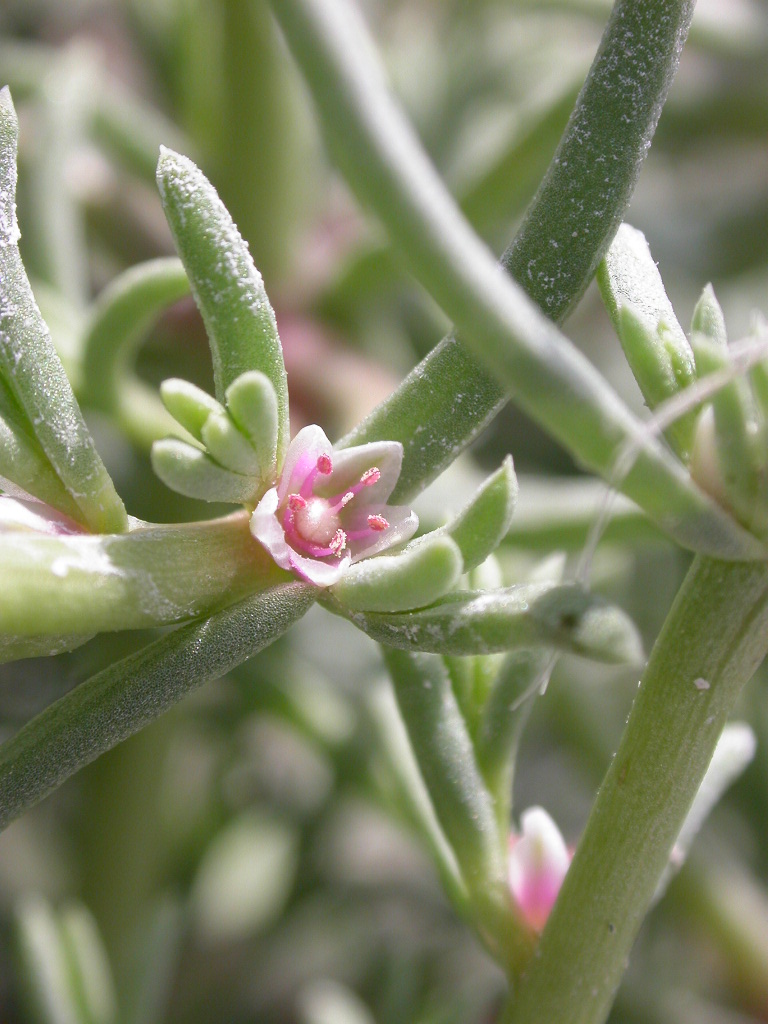
 Nitrophila occidentalis is a species of flowering plant in the amaranth family known by the common name boraxweed. It is native to the western United States and northern Mexico, where it can be found in habitat with moist alkaline soils, such as salt pans. It is a rhizomatous perennial herb producing decumbent or erect stems up to about 30 centimeters tall. The stems have paired branches lined with oppositely arranged, fleshy, linear or oblong green leaves up to 1.6 centimeters in length. Flowers occur in the leaf axils, alone or in clusters of up to 3, accompanied by small bracts. The flower lacks petals but has five pointed sepals 1 or 2 millimeters long which are white or pink in color, fading white with age.
Nitrophila occidentalis is a species of flowering plant in the amaranth family known by the common name boraxweed. It is native to the western United States and northern Mexico, where it can be found in habitat with moist alkaline soils, such as salt pans. It is a rhizomatous perennial herb producing decumbent or erect stems up to about 30 centimeters tall. The stems have paired branches lined with oppositely arranged, fleshy, linear or oblong green leaves up to 1.6 centimeters in length. Flowers occur in the leaf axils, alone or in clusters of up to 3, accompanied by small bracts. The flower lacks petals but has five pointed sepals 1 or 2 millimeters long which are white or pink in color, fading white with age. Stem: decumbent to erect. Leaf: sessile, occasionally scale-like on decumbent stems. Inflorescence: bracts 2; flowers 1, sessile, or 2–3, short-pedicelled. Flower: calyx 2–3.3 mm, pink, white in age. Seed: ± 1 mm, black or brown, dull.
Stem: decumbent to erect. Leaf: sessile, occasionally scale-like on decumbent stems. Inflorescence: bracts 2; flowers 1, sessile, or 2–3, short-pedicelled. Flower: calyx 2–3.3 mm, pink, white in age. Seed: ± 1 mm, black or brown, dull.
Dianthus gratianopolitanus (Cheddar pink) is a species belonging to the Caryophyllaceae family. It is a herbaceous perennial, hardy to zones 4-8. It grows to a height of 0.5 to 1 feet, blooming from May to June. Flowers are fragrant and rose pink. Grows best in full sun, and has medium water requirements. Overwatering or poor drainage leads to crown rot, and they do not tolerate wet winter soil conditions.
 This dianthus cultivar is one of the cheddar pinks. It is a mat-forming perennial which produces numerous scented rose-pink flowers (to 1.5" diameter) singly or in twos atop wiry stems (to 12" tall) arising from tufted mounds of grassy, gray-green, linear foliage. Flowers are larger than those of most other cultivars in this species, hence the common name. Blooms in spring with some intermittent rebloom in summer, particularly if flowers are promptly deadheaded before producing seed.
This dianthus cultivar is one of the cheddar pinks. It is a mat-forming perennial which produces numerous scented rose-pink flowers (to 1.5" diameter) singly or in twos atop wiry stems (to 12" tall) arising from tufted mounds of grassy, gray-green, linear foliage. Flowers are larger than those of most other cultivars in this species, hence the common name. Blooms in spring with some intermittent rebloom in summer, particularly if flowers are promptly deadheaded before producing seed.
Cheddar pinks are best in rock gardens, border fronts or in some difficult sites such as rocky slopes or over stone walls. Effective small area ground cover. Also an effective edging plant.
Easily grown in average, medium, well-drained soil in full sun. Well-drained soils are essential to prevent crown rot. Plants will usually not survive in wet winter soils. Plants prefer slightly alkaline soils. Species tolerates heat and humidity (as well as some drought) better than most other species of dianthus. Remove spent flowers to promote continued bloom. After flowering is completed, plants may be lightly sheared back to maximize foliage effect as a dense ground cover.
Celosia argentea, commonly known as plumed cockscomb, or the silver cock's comb, is a herbaceous plant of tropical origin, and is known for its very bright colors. In India and China it is known as a troublesome weed.
Celosia argentea is a tender annual that is often grown in gardens. It blooms in mid-spring to summer. It is propagated by seeds. The seeds are extremely small, up to 43,000 seeds per ounce. The flowers are hermaphrodites.
As these plants are of tropical origin, they grow best in full sunlight and should be placed in a well drained area. The flowerheads can last up to 8 weeks, and further growth can be promoted by removing dead flowers.'=
 Celosia argentea var. cristata 'Flamingo Feathers' is a cultivar that can grow up to 2 feet in height. The colors are predominantly pink to light violet, and the leaves are a darker green than other cultivars. The Century cultivars are usually taller (1–2 feet), and are bright red, yellow, orange, or pink. The Kimono cultivars are generally smaller (4 inches - 1 foot), and have more muted colors, though similar to the Century cultivars. Other colors, such as white, burgundy, orange-red, etc., can be found. Certain varieties will grow to 3–4 feet in height.[4] Celosia plumosa, also known as Prince of Wales Feathers, is a synonym for Celosia argentea. Often sold as C. plumosa 'Prince of Wales Feathers'. Seeds may be sold as mixtures.
Celosia argentea var. cristata 'Flamingo Feathers' is a cultivar that can grow up to 2 feet in height. The colors are predominantly pink to light violet, and the leaves are a darker green than other cultivars. The Century cultivars are usually taller (1–2 feet), and are bright red, yellow, orange, or pink. The Kimono cultivars are generally smaller (4 inches - 1 foot), and have more muted colors, though similar to the Century cultivars. Other colors, such as white, burgundy, orange-red, etc., can be found. Certain varieties will grow to 3–4 feet in height.[4] Celosia plumosa, also known as Prince of Wales Feathers, is a synonym for Celosia argentea. Often sold as C. plumosa 'Prince of Wales Feathers'. Seeds may be sold as mixtures.
Xerophyta retinervis is a deciduous perennial up to 2 metres tall with stout, erect stems, densely covered in persistent, fibrous leaf bases, often charred and blackened by veldfires. Fragrant flowers appear after fire or rain, and are blue or mauve, or rarely white. The small capsules are covered in rough hairs and are loculicidally dehiscent, releasing numerous small, black angled seeds about 2 mm long. The species is tolerant of extreme conditions such as drought, fire, and low temperatures. The old leaf bases are arranged so that rainwater is funnelled down and to the core, where it is absorbed by densely packed roots that run the entire length of the stem. Strap-shaped leaves occur in tufts along stems.
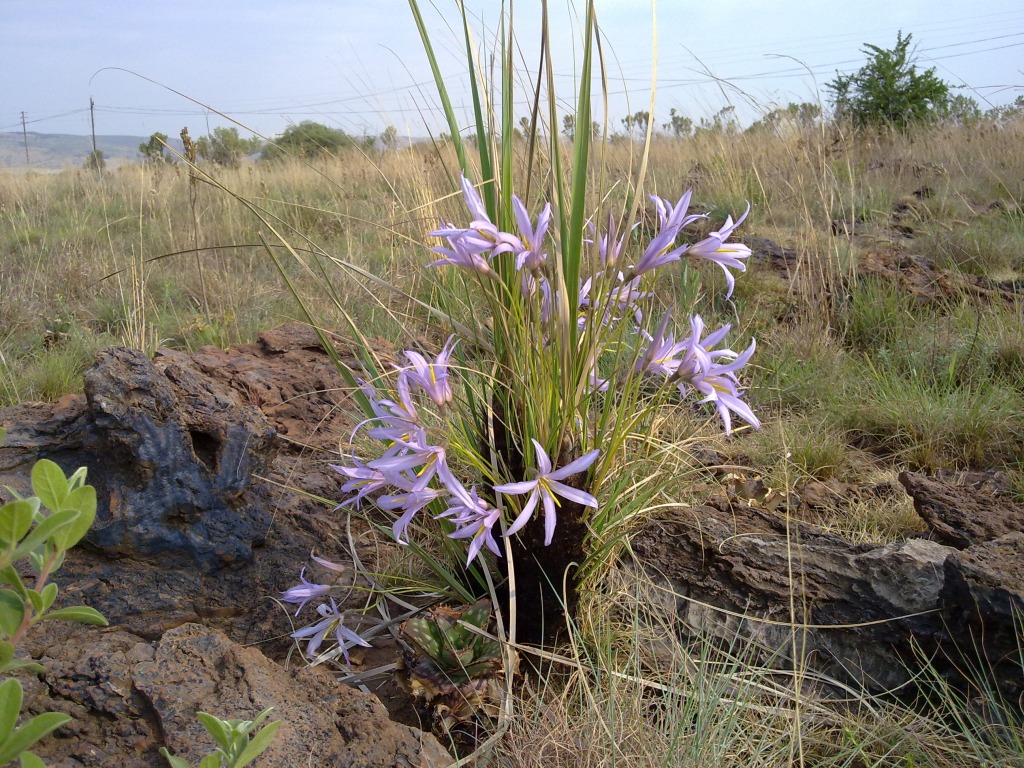 The species is widespread throughout seasonally high rainfall regions, occurring in grasslands on rocky outcrops, and sheetrock with a covering of shallow soil. It may be found through KwaZulu-Natal, Mpumalanga, Gauteng, Limpopo, North West Province, Botswana and Swaziland.
There are some 50 species in this genus, nine occurring in South Africa. The generic name is from the Greek 'xeros' = 'arid', and 'phytos' = 'plant' an allusion to its being drought-tolerant, while the specific name is Latin for 'vein network'. Plants collected by Burke & Zeyher in the Magaliesberg were described by Baker in 1875. Synonyms have included Barbacenia retinervis (Baker) Burtt Davy, Hypoxis vellosioides Harv. ex Baker, Vellozia clavata (Baker) Baker Vellozia retinervis (Baker) Baker and Xerophyta clavata Baker.
The species is widespread throughout seasonally high rainfall regions, occurring in grasslands on rocky outcrops, and sheetrock with a covering of shallow soil. It may be found through KwaZulu-Natal, Mpumalanga, Gauteng, Limpopo, North West Province, Botswana and Swaziland.
There are some 50 species in this genus, nine occurring in South Africa. The generic name is from the Greek 'xeros' = 'arid', and 'phytos' = 'plant' an allusion to its being drought-tolerant, while the specific name is Latin for 'vein network'. Plants collected by Burke & Zeyher in the Magaliesberg were described by Baker in 1875. Synonyms have included Barbacenia retinervis (Baker) Burtt Davy, Hypoxis vellosioides Harv. ex Baker, Vellozia clavata (Baker) Baker Vellozia retinervis (Baker) Baker and Xerophyta clavata Baker.

Freycinetia arborea, ʻIeʻie, is a densely branched, brittle, woody climber in the family Pandanaceae, endemic to the Pacific Islands. ʻIeʻie is found in moist forest on the Hawaiian, Marquesas, Austral, Society, and Cook Islands. It grows into the forest canopy, attaching itself to a host tree using aerial roots. It may also grow as a sprawling tangle on the forest floor.
 The shiny green leaves have pointed ends and are spiny on the lower side of the midrib and along the edges.Leaves measure 40–80 centimetres (16–31 in) long and 1–3 centimetres (0.39–1.18 in) wide, and are spirally arranged around the ends of branches. Flowers form on spike-like inflorescences at the end of branches, and are either staminate or pistillate. Staminate spikes are yellowish-white and up to 10 centimetres (3.9 in) in length.
The shiny green leaves have pointed ends and are spiny on the lower side of the midrib and along the edges.Leaves measure 40–80 centimetres (16–31 in) long and 1–3 centimetres (0.39–1.18 in) wide, and are spirally arranged around the ends of branches. Flowers form on spike-like inflorescences at the end of branches, and are either staminate or pistillate. Staminate spikes are yellowish-white and up to 10 centimetres (3.9 in) in length.
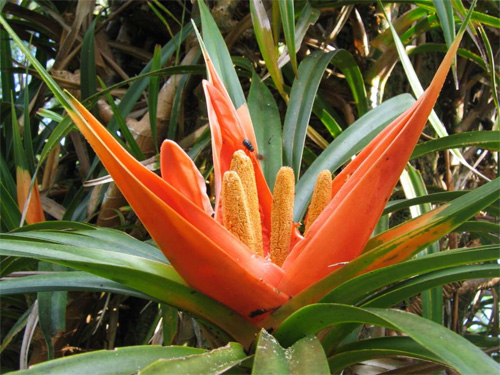 Pistillate spikes are 3–4 centimetres (1.2–1.6 in) but elongate to 7.5–9.5 centimetres (3.0–3.7 in) once fruit are produced. Three to four spikes are surrounded by orange-salmon bracts. Fruit is 1 centimetre (0.39 in) long and contains many 1.5-millimetre (0.059 in) seeds. The bracts and fruit of the ʻieʻie were a favorite food of the ʻōʻū (Psittirostra psittacea), an extinct Hawaiian honeycreeper that was formerly a principal seed dispersal vector for plants with small seeded, fleshy fruits in low elevation forests. It is also a favored food of the ʻalalā (Corvus hawaiiensis), which is currently extinct in the wild.
Pistillate spikes are 3–4 centimetres (1.2–1.6 in) but elongate to 7.5–9.5 centimetres (3.0–3.7 in) once fruit are produced. Three to four spikes are surrounded by orange-salmon bracts. Fruit is 1 centimetre (0.39 in) long and contains many 1.5-millimetre (0.059 in) seeds. The bracts and fruit of the ʻieʻie were a favorite food of the ʻōʻū (Psittirostra psittacea), an extinct Hawaiian honeycreeper that was formerly a principal seed dispersal vector for plants with small seeded, fleshy fruits in low elevation forests. It is also a favored food of the ʻalalā (Corvus hawaiiensis), which is currently extinct in the wild.
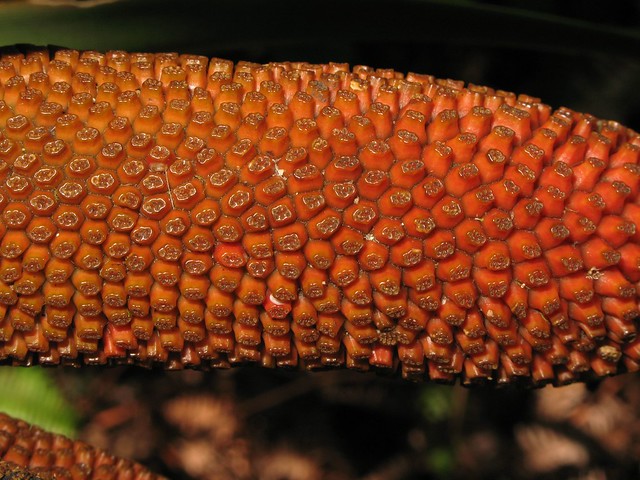
Typha latifolia (bulrush, common bulrush, broadleaf cattail, common cattail, great reedmace, cooper's reed, cumbungi) is a perennial herbaceous plant in the genus Typha. It is found as a native plant species in North and South America, Europe, Eurasia, and Africa. In Canada, broadleaf cattail occurs in all provinces and also in the Yukon and Northwest Territories, and in the United States, it is native to all states except Hawaii. It is an introduced and invasive species, and considered a noxious weed, in Australia and Hawaii. It is not native but has been reported in Indonesia, Malaysia, New Zealand, Papua New Guinea, and the Philippines.
/Typha%20latifolia1b.jpg) T. latifolia has been found in a variety of climates, including tropical, subtropical, southern and northern temperate, humid coastal, and dry continental. It is found at elevations from sea level to 7,500 feet (2,300 m).
T. latifolia is an "obligate wetland" species, meaning that it is always found in or near water. The species generally grows in flooded areas where the water depth does not exceed 2.6 feet (0.8 meters).[9] However, it has also been reported growing in floating mats in slightly deeper water. T. latifolia grows mostly in fresh water but also occurs in slightly brackish marshes. The species can displace other species native to salt marshes upon reduction in salinity. Under such conditions the plant may be considered invasive, since it interferes with preservation of the salt marsh habitat.
T. latifolia has been found in a variety of climates, including tropical, subtropical, southern and northern temperate, humid coastal, and dry continental. It is found at elevations from sea level to 7,500 feet (2,300 m).
T. latifolia is an "obligate wetland" species, meaning that it is always found in or near water. The species generally grows in flooded areas where the water depth does not exceed 2.6 feet (0.8 meters).[9] However, it has also been reported growing in floating mats in slightly deeper water. T. latifolia grows mostly in fresh water but also occurs in slightly brackish marshes. The species can displace other species native to salt marshes upon reduction in salinity. Under such conditions the plant may be considered invasive, since it interferes with preservation of the salt marsh habitat.
 T. latifolia shares its range with other related species, and hybridizes with Typha angustifolia, narrow-leaf cattail, to form Typha × glauca (Typha angustifolia × T. latifolia), white cattail.Common cattail is usually found in shallower water than narrow-leaf cattail.
The plant is 1.5 to 3 metres (5 to 10 feet) high and it has 2–4 cm (¾ to 1½ inch) broad leaves, and will generally grow out in to 0.75 to 1 metre (2 to 3 feet) of water depth.
T. latifolia shares its range with other related species, and hybridizes with Typha angustifolia, narrow-leaf cattail, to form Typha × glauca (Typha angustifolia × T. latifolia), white cattail.Common cattail is usually found in shallower water than narrow-leaf cattail.
The plant is 1.5 to 3 metres (5 to 10 feet) high and it has 2–4 cm (¾ to 1½ inch) broad leaves, and will generally grow out in to 0.75 to 1 metre (2 to 3 feet) of water depth.
 Traditionally, Typha latifolia has been a part of many native North American cultures, as a source of food, medicine, and for other uses. The rhizomes are edible after cooking and removing the skin, while peeled stems and leaf bases can be eaten raw, or cooked. Young flower spikes are edible as well. Some cultures make use of the roots of T. latifolia as a poultice for boils, burns, or wounds.The Hopi Kachinas give the plant to children with toys attached, such as bows and dolls during the Home Dance.
While Typha latifolia grows all over, including in rural areas, it is not advisable to eat specimens deriving from polluted water as it is used as a bioremediator, it absorbs pollutants. Do not eat them if they taste very bitter or spicy.
Traditionally, Typha latifolia has been a part of many native North American cultures, as a source of food, medicine, and for other uses. The rhizomes are edible after cooking and removing the skin, while peeled stems and leaf bases can be eaten raw, or cooked. Young flower spikes are edible as well. Some cultures make use of the roots of T. latifolia as a poultice for boils, burns, or wounds.The Hopi Kachinas give the plant to children with toys attached, such as bows and dolls during the Home Dance.
While Typha latifolia grows all over, including in rural areas, it is not advisable to eat specimens deriving from polluted water as it is used as a bioremediator, it absorbs pollutants. Do not eat them if they taste very bitter or spicy.
Nepenthes adnats is a tropical pitcher plant endemic to the Indonesian province of West Sumatra, where it grows at elevations of 600 to 1200 m above sea level. The specific epithet adnata is Latin for "broadly attached" and refers to the base of the lamina.
 Nepenthes adnata was first collected by Willem Meijer on August 24, 1957. The holotype, Meijer 6941, was collected on that date near the river Tjampo, east of Payakumbuh, Taram, West Sumatra, at an elevation of 1000 m. It is deposited at the National Herbarium of the Netherlands in Leiden.
The species was first described in 1986 by Mitsuru Hotta and Rusjdi Tamin based on specimens the authors collected near Harau in West Sumatra. However, the description was invalid as it lacked a Latin diagnosis. This was provided eight years later by Jan Schlauer.
Nepenthes adnata was first collected by Willem Meijer on August 24, 1957. The holotype, Meijer 6941, was collected on that date near the river Tjampo, east of Payakumbuh, Taram, West Sumatra, at an elevation of 1000 m. It is deposited at the National Herbarium of the Netherlands in Leiden.
The species was first described in 1986 by Mitsuru Hotta and Rusjdi Tamin based on specimens the authors collected near Harau in West Sumatra. However, the description was invalid as it lacked a Latin diagnosis. This was provided eight years later by Jan Schlauer.
Nepenthes adnata is a diminutive species. The stem is cylindrical in cross section and may be climbing or drooping. It rarely exceeds 2 m in length and 3 mm in diameter. Internodes are up to 10 cm long.
Leaves are coriaceous and sessile. The lamina is lanceolate-ellipsoidal and may be up to 10 cm long and 2 cm wide. It has an adnate base and an obtuse to acute apex. Two to three longitudinal veins are present on either side of the midrib. Pinnate veins are not easily distinguished. Tendrils may be up to 5 cm long.
Rosette and lower pitchers are ovoid in the lower third and cylindrical above. They are small, reaching only 10 cm in height and 2.5 cm in width. A pair of fringed wings (≤3 mm wide) runs down the front of terrestrial pitchers. The glandular region covers only the lower third of the inner pitcher surface. The pitcher mouth is round and slightly oblique throughout. The cylindrical peristome is up to 2 mm wide and bears indistinct teeth. The peristome is roughly symmetrical in cross section, with the inner portion accounting for around 54% of its total cross-sectional surface length. The lid or operculum is orbicular and cordate at the base. Multicellular hairs are sometimes present on its upper surface. An unbranched spur (≤2 mm long) is inserted at the base of the lid.
 Upper pitchers are ovoid in the lower quarter and cylindrical to infundibular above. In aerial pitchers, the wings are usually reduced to ribs, but sometimes bear fringe elements. In most other respects, they are similar to lower pitchers.
Upper pitchers are ovoid in the lower quarter and cylindrical to infundibular above. In aerial pitchers, the wings are usually reduced to ribs, but sometimes bear fringe elements. In most other respects, they are similar to lower pitchers.
Nepenthes peltata is a tropical pitcher plant known only from the upper slopes of Mount Hamiguitan on the island of Mindanao in the Philippines. It is characterised by a peltate tendril attachment and conspicuous indumentum. The species typically produces ovoid pitchers with a prominent basal crest and large nectar glands on the lower surface of the lid.
The specific epithet peltata is Latin for "peltate" and refers to the distinctive tendril insertion of this species.
Nepenthes peltata is a scrambling plant typically growing to a height of 1 m, although stems up to 3 m long have been recorded. The species does not appear to produce a climbing stem.
The lamina (leaf blade) is oblong in shape and reaches 50 cm in length by 9 cm in width. The apex of the lamina is rounded, while the base is abruptly contracted into the petiole, which is canaliculate and up to 7 cm long in mature plants. Young plants may have sessile leaves lacking a petiole. The lower surface of the lamina is often dark red in colour, contrasting sharply with the dark green upper surface. The margins of the lamina are sometimes curled upwards. Tendrils have a peltate insertion, with the point of attachment being up to 27 mm from the apex.
 Rosette and lower pitchers vary widely in morphology, ranging from ellipsoidal to urceolate or entirely ovate. They are relatively large, growing to 28 cm in height by 16 cm in width. A pair of wings (≤10 mm wide), with fringe elements up to 9 mm long, runs down the ventral surface of the pitcher cup. The peristome is approximately cylindrical and up to 2 cm wide. It bears ribs up to 1.5 mm high and spaced up to 2 mm apart, which may terminate in teeth up to 1 mm long.
Rosette and lower pitchers vary widely in morphology, ranging from ellipsoidal to urceolate or entirely ovate. They are relatively large, growing to 28 cm in height by 16 cm in width. A pair of wings (≤10 mm wide), with fringe elements up to 9 mm long, runs down the ventral surface of the pitcher cup. The peristome is approximately cylindrical and up to 2 cm wide. It bears ribs up to 1.5 mm high and spaced up to 2 mm apart, which may terminate in teeth up to 1 mm long.
 The pitcher lid or operculum is ovate to elliptic in shape and measures up to 8 cm in length by 6 cm in width. A triangular basal crest is sometimes present on the underside of the lid together with scattered giant nectar glands measuring up to 3 mm across. An unbranched spur (≤12 mm long) is inserted near the base of the lid.
The pitcher lid or operculum is ovate to elliptic in shape and measures up to 8 cm in length by 6 cm in width. A triangular basal crest is sometimes present on the underside of the lid together with scattered giant nectar glands measuring up to 3 mm across. An unbranched spur (≤12 mm long) is inserted near the base of the lid.
 Nepenthes peltata has a racemose inflorescence measuring up to 75 cm in length. Its thickness varies from up to 3.5 cm in males to up to 6.5 cm in females. The peduncle itself may be up to 46 cm long and 9 mm wide, while the rachis can reach 20 cm. Partial peduncles are mostly two-flowered and bear a bract (≤7 mm long). Their unbranched basal portion is up to 3 mm long, while the branches reach 14 mm. The ovate tepals measure up to 4 mm in length and have an acute apex. Fruits are approximately 20 mm long, while seeds measure around 4 mm.
Nepenthes peltata has a racemose inflorescence measuring up to 75 cm in length. Its thickness varies from up to 3.5 cm in males to up to 6.5 cm in females. The peduncle itself may be up to 46 cm long and 9 mm wide, while the rachis can reach 20 cm. Partial peduncles are mostly two-flowered and bear a bract (≤7 mm long). Their unbranched basal portion is up to 3 mm long, while the branches reach 14 mm. The ovate tepals measure up to 4 mm in length and have an acute apex. Fruits are approximately 20 mm long, while seeds measure around 4 mm.
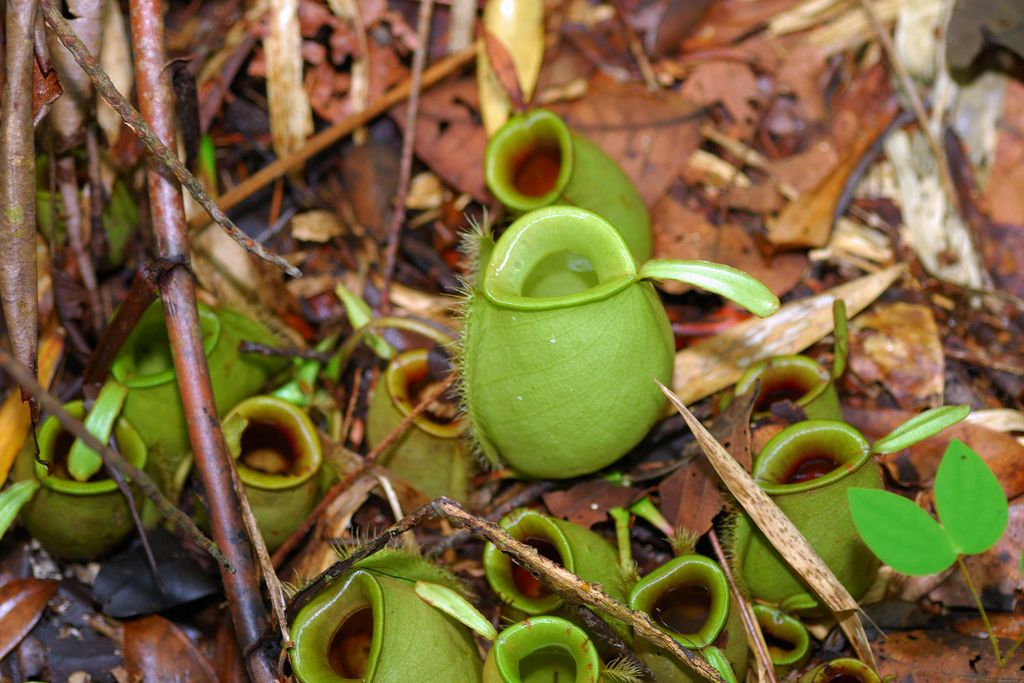 Nepenthes ampullaria is a very distinctive and widespread species of tropical pitcher plant, present in Borneo, the Maluku Islands, New Guinea, Peninsular Malaysia, Singapore, Sumatra, and Thailand.
Nepenthes ampullaria, unlike other members of its genus, has evolved away from carnivory and the plants are partly detritivores, collecting and digesting falling leaf litter in their pitchers.
In the 1996 book Pitcher-Plants of Borneo, N. ampullaria is given the vernacular name flask-shaped pitcher-plant. This name, along with all others, was dropped from the much-expanded second edition, published in 2008.
Nepenthes ampullaria is a very distinctive and widespread species of tropical pitcher plant, present in Borneo, the Maluku Islands, New Guinea, Peninsular Malaysia, Singapore, Sumatra, and Thailand.
Nepenthes ampullaria, unlike other members of its genus, has evolved away from carnivory and the plants are partly detritivores, collecting and digesting falling leaf litter in their pitchers.
In the 1996 book Pitcher-Plants of Borneo, N. ampullaria is given the vernacular name flask-shaped pitcher-plant. This name, along with all others, was dropped from the much-expanded second edition, published in 2008.
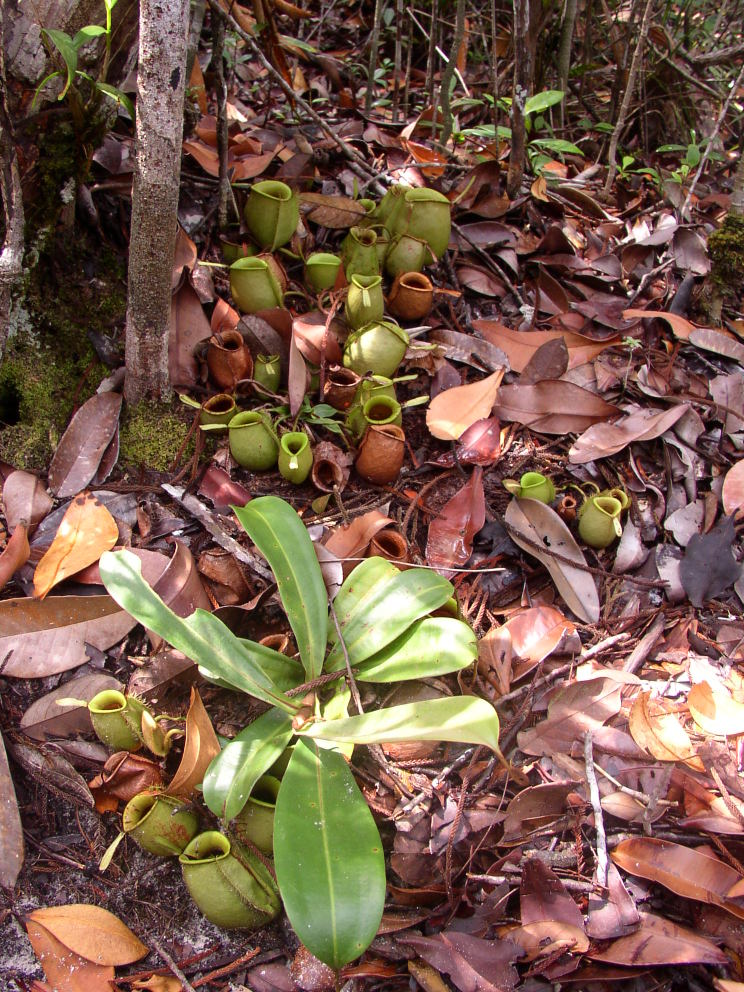 The stem of N. ampullaria is light brown in colour and may climb to 15 m in height. Leaves are light green, up to 25 cm long, and 6 cm wide. Pitchers are produced at the ends of short tendrils no more than 15 cm long.
The urceolate pitchers are generally quite small, rarely exceeding 10 cm in height and 7 cm in width. The peristome is greatly incurved, with the inner section accounting for around 85% of its total cross-sectional surface length. Upper pitchers are very rarely produced and are considerably smaller than those formed on rosettes or offshoots. Pitchers range in colouration from light green throughout to completely dark red, with many intermediate forms recorded. The pitchers of N. ampullaria from Sumatra and Peninsular Malaysia are almost exclusively green throughout or green with red speckles; the red forms are mostly confined to Borneo. A large-pitchered form has been recorded from New Guinea.
The stem of N. ampullaria is light brown in colour and may climb to 15 m in height. Leaves are light green, up to 25 cm long, and 6 cm wide. Pitchers are produced at the ends of short tendrils no more than 15 cm long.
The urceolate pitchers are generally quite small, rarely exceeding 10 cm in height and 7 cm in width. The peristome is greatly incurved, with the inner section accounting for around 85% of its total cross-sectional surface length. Upper pitchers are very rarely produced and are considerably smaller than those formed on rosettes or offshoots. Pitchers range in colouration from light green throughout to completely dark red, with many intermediate forms recorded. The pitchers of N. ampullaria from Sumatra and Peninsular Malaysia are almost exclusively green throughout or green with red speckles; the red forms are mostly confined to Borneo. A large-pitchered form has been recorded from New Guinea.

The inflorescence of N. ampullaria is a dense panicle. It is the only Nepenthes species recorded from Sumatra or Peninsular Malaysia that produces paniculate inflorescences.
All parts of the plant are densely covered with short, brown hairs when young. The indumentum of mature plants is more sparse, except on the inflorescences.













/Typha%20latifolia1b.jpg)









